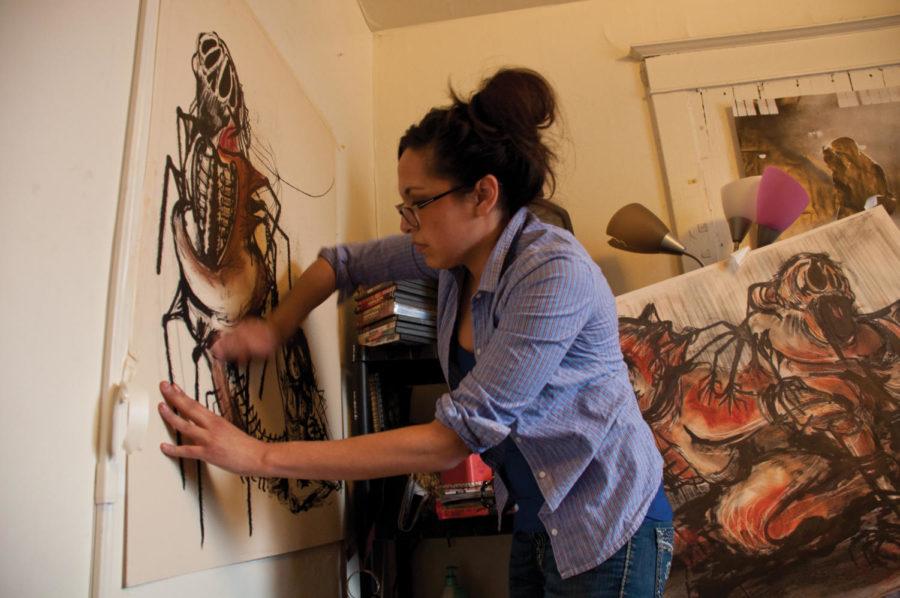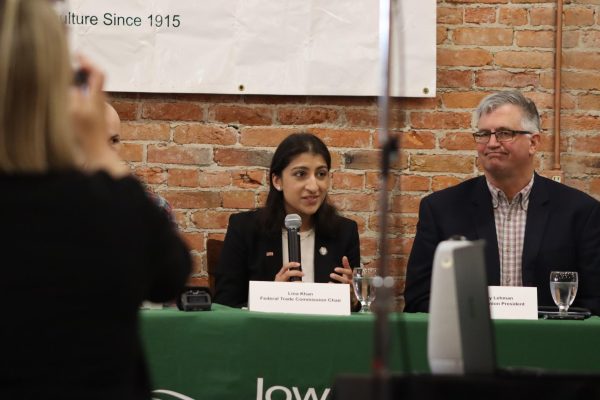Native American student shares struggle, dispels stereotypes
Photo: Karuna Ang/Iowa State Daily
Renelle White Buffalo, senior in integrated studio arts, works on her drawings at her apartment. She said her art is influenced by her mother, as her mother had a monster just like everyone else, and alcohol fueled her monster and it eventually took over.
April 25, 2011
Murdo is a convergence of checkered white and Native American land in Jones County, S.D.
A town just a half-hour outside of White River, S.D., and 23 miles north of the Rosebud Indian Reservation in Todd County, Murdo is a place where the most common last name isn’t Smith but is White Buffalo, Stands And Looks Back or Black Bear.
Renelle White Buffalo, senior in integrated studio arts, was raised by her grandmother and grandfather in this area.
Today, she and nearly 100 other ISU students identify as Native American.
“It varies from 20 or so up to around 100,” said Sidner Larson, director of American Indian studies and associate professor of English. “And it’s a thing that seems to be largely influenced by the state of the economy. Because the economy is in such rough shape, our number of American Indian students has really plummeted.”
For years, there has been a widespread stereotype of American Indians getting to attend college for free or receiving access and outside support to put toward an education, which Larson said is untrue.
“Generally speaking, American Indians have much fewer resources than do other cultural groups,” Larson said.
Living Lakota
White Buffalo was not raised in a traditional Lakota way.
She didn’t attend powwows or live in a teepee like her other classmates growing up. [Clarification: She didn’t attend powwows, as often as her other classmates did growing up. She did not live in a teepee as historically the tribe would have, nor did her classmates.]
In a broken language, her grandmother would teach her Lakota words.
“Wa-call-uh-pee,” she said, teaching the Lakota word for coffee.
Her grandmother understood the language more than she could speak it.
“Wa-touch-uh,” she would repeat to her granddaughter, the word for leftovers. [Clarification: “Wa-call-uh-pee” and “wa-touch-uh” were the reporter’s phonetic interpretations of the Lakota words for coffee and leftovers.]
Her grandparents were the best part of her life.
She lived with them until her grandmother died when White Buffalo was in eighth grade.
Her grandfather moved to a nursing home, and White Buffalo was forced to move in with her alcoholic mother, two brothers and one [corrected from: two] sisters.
“When I was in high school and middle school, I didn’t want to be Native American,” White Buffalo said. “I was so bitter about my mom and the bums drinking on the street and all of the bad things that I saw.”
She would wake up each morning to find her mother passed out, face-first in the food she was eating the night before, on the toilet or in the bathtub.
The other children pushed their mother aside so they could eat breakfast and use the bathroom.
White Buffalo took over the household — paying the bills and getting her siblings ready for school every day.
“It felt like I was trying to please [my mom] so much,” White Buffalo said.
Graduating salutatorian from White River High School with a class of 22, she was the homecoming queen, prom queen, president of most of the clubs and a straight-A student.
“That was the most frustrating thing … to live with a mom that didn’t love you and loved alcohol more,” she said.
White Buffalo still doesn’t speak to her mother.
Her youngest sister and mother started sending her Happy Birthday cards with hateful messages inside.
“They would say, ‘Hey, happy birthday. I hope you…,'” she said, laughing.
White Buffalo and her brother William are the closest. They didn’t speak for a year because of their mother, but they are in contact now. Her other brother is upset about how his life has turned out, and neither he nor her younger sister will speak to her.
“I feel like once they’re older and step outside of the situation,” she said, trailing off but later finishing her thought that her siblings will understand that they can have a better life.
She attended Northern State University in South Dakota and transferred to Iowa State in the spring of 2008 to pursue her dreams of becoming an artist and, mostly, to leave behind South Dakota, the reservation and her mother.
The reservation way
“Res-love” is the term used when women on a reservation have “hickies” and bruises all over their bodies. It’s one of the main issues White Buffalo works toward raising awareness for as the only member of the Native American Club this semester.
“People just say, ‘That’s res-love,'” White Buffalo said. “People make fun of it in order to deal with it and in order to cope. I think that’s a huge problem.”
It isn’t just res-love that was infecting her reservation, though.
“American Indians, as a general rule, live in what contemporary scholars call enforced poverty,” Larson said.
Larson, director of American Indian Studies for 11 years, continued.
“They are made to live in greatly diminished circumstances creating the stereotype of the dysfunctional and the savage,” he said.
Larson said there is an alcohol problem in many tribal communities, but under the circumstances, any cultural group would most likely medicate itself pretty heavily.
“It’s not as simple as they’re just all alcoholics,” he said. “It’s like the stereotype [of American] Indian students getting to go to college for free. It’s just not that simple.”
One of the reasons the American Indian student population is down is that students across the board are having money problems and those are magnified by 100 percent for American Indians, Larson said.
American Indians at Iowa State
“I’ll bet if you ask a person on the street however they think that Indians [pay for school], they probably think Indians go to college free,” Larson said. “I’m a card-carrying, actual existing tribal member. I had to borrow, beg and steal like everyone else.”
White Buffalo, one-quarter Lakota, isn’t going to school for free or receiving special scholarships.
She didn’t know they were available to her until it was too late to apply for them.
She is receiving in-state tuition as a non-resident because her Lakota tribe boundaries fall within Iowa territory.
If students have the appropriate amount of tribal blood that has historically been a part of Iowa territory before Iowa became a state, those individuals are qualified to receive Iowa residency status for tuition purposes only.
Iowa State started to allow out-of-state students to pay in-state tuition in the summer of 1998 if they could show evidence of being affiliated with one of 13 Iowa tribes; the students are still classified as a non-resident.
Since 1998, 41 students have applied to pay in-state tuition, 15 of which are currently enrolled.
“There aren’t that many Native American students here,” said Lynn Paxson, adviser for the Native American Student Association and associate professor of architecture.
According to the Office of the Registrar, two students received funding through the Bureau of Indian Affairs during school year 2008-2009 and one received in-state tuition during school year 2009-2010.
“They have to make sure they have proof from the Bureau of Indian Affairs from their tribe proving they have verification,” said Judy Minnick, assistant registrar. “It’s a great opportunity for them to get that tuition. We’ll allow them to do that as long as they’re enrolled.”
Students often have a tribal card or a letter from the bureau. Some will have a certificate that ties in with their grandparents.
“Lots of people have native backgrounds, but they’re not enrolled,” Paxson said.
“If you say you’re black, nobody gets to say whether you are or not. For Native Americans, that’s a legal definition in this country. You can have the native background but not get to claim it legally,” Paxson said.
In the American Indian context, being enrolled means you are officially a member of a tribe.
Those who receive in-state tuition are mostly from Minnesota. Nebraska is close behind and North Dakota, Wisconsin and the rest of Iowa’s neighboring states follow.
The turnaround
“When I went to college, everybody kept asking me questions about being Native American and where did my last name come from,” White Buffalo said. “I decided to research more on it, and I kind of fell in love with the beauty of my culture. I’m going to be what my past leaders were, not what my culture is currently.”
She hopes to play a part in changing the negative aspects of the reservation, whether with her actions through the club or with the art that she creates.
As the only member of the Native American Club and someone who is still learning about her culture, White Buffalo feels like she is judged by Native Americans.
People scold her for not knowing the language, dances and continuously go through the cultural criteria.
“I’m proud to be Native American and [I] value all the virtues,” she said. “I know a lot, but I don’t know everything.”
White Buffalo said that although she came from a broken family with an alcoholic mother, she doesn’t have a problem with drinking.
She is 23 years old and as long as it doesn’t interfere with a person’s obligations, she drinks, but she is still careful not to let others perceive her as having a problem.
There is still a lot of pressure on her when she goes out because she is an American Indian, she said.
Without the discrimination, White Buffalo finds it difficult to make a connection with anyone and to share her culture.
She can’t use slang terms from the Lakota language or ask someone if they want to go get some coffee using the language her grandmother taught her when she was young.
She also has people come up to her and talk about how they are 1/36th Native American and they are receiving scholarship money or in-state tuition.
She knows there are standards, but she doesn’t like when people are claiming money but don’t show an interest in the culture.
“It’s hard to say there are Native Americans on campus because I’m the only one in the culture club and … where are they at?” she said.
White Buffalo does miss South Dakota, though, but mostly the Black Hills and Badlands.
She said she will someday return to the checkered white and Indian land — the area a half-hour outside of White River and north of the reservation, Murdo, the place where her family is, and where there isn’t a Smith for miles.

















